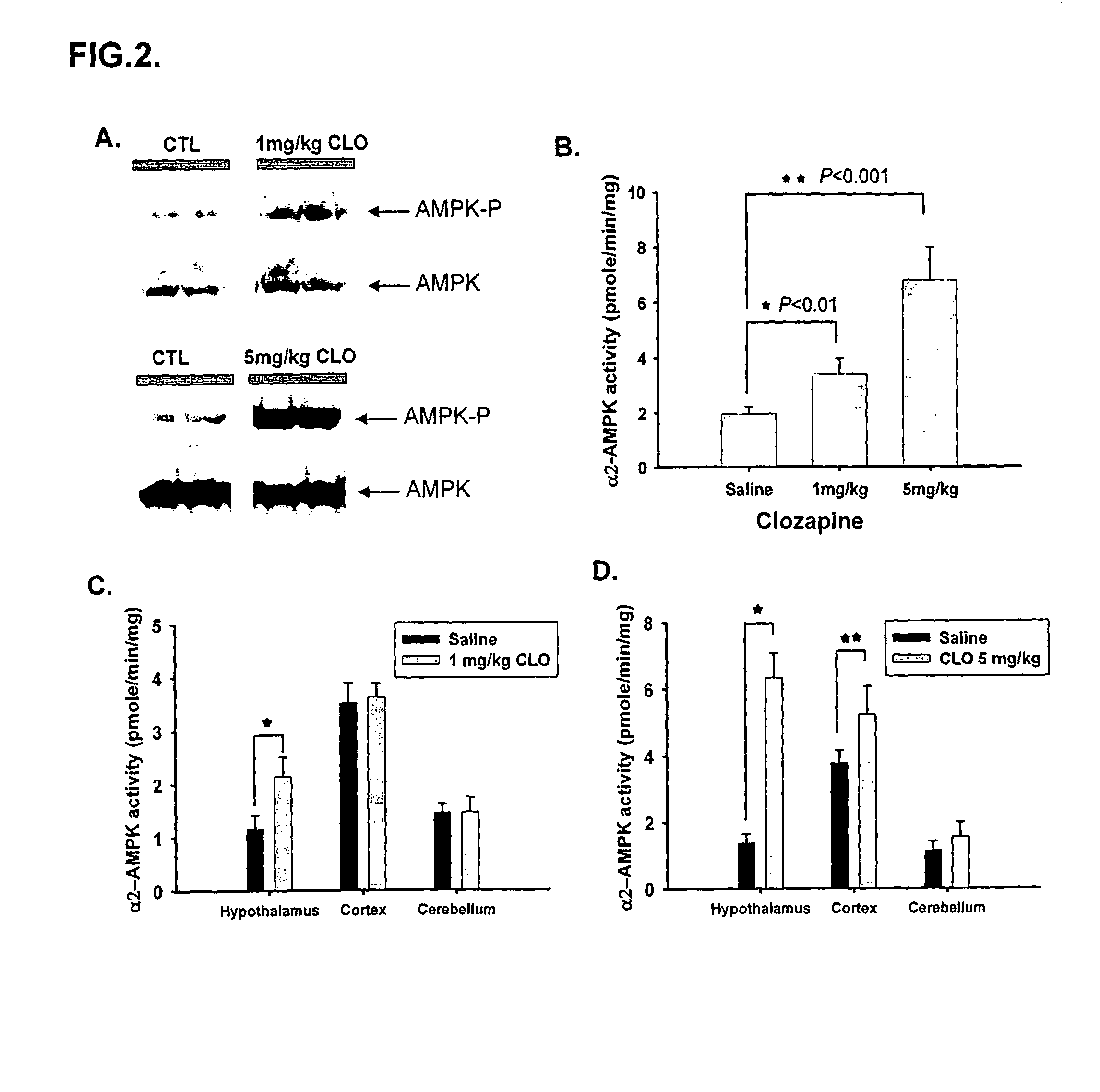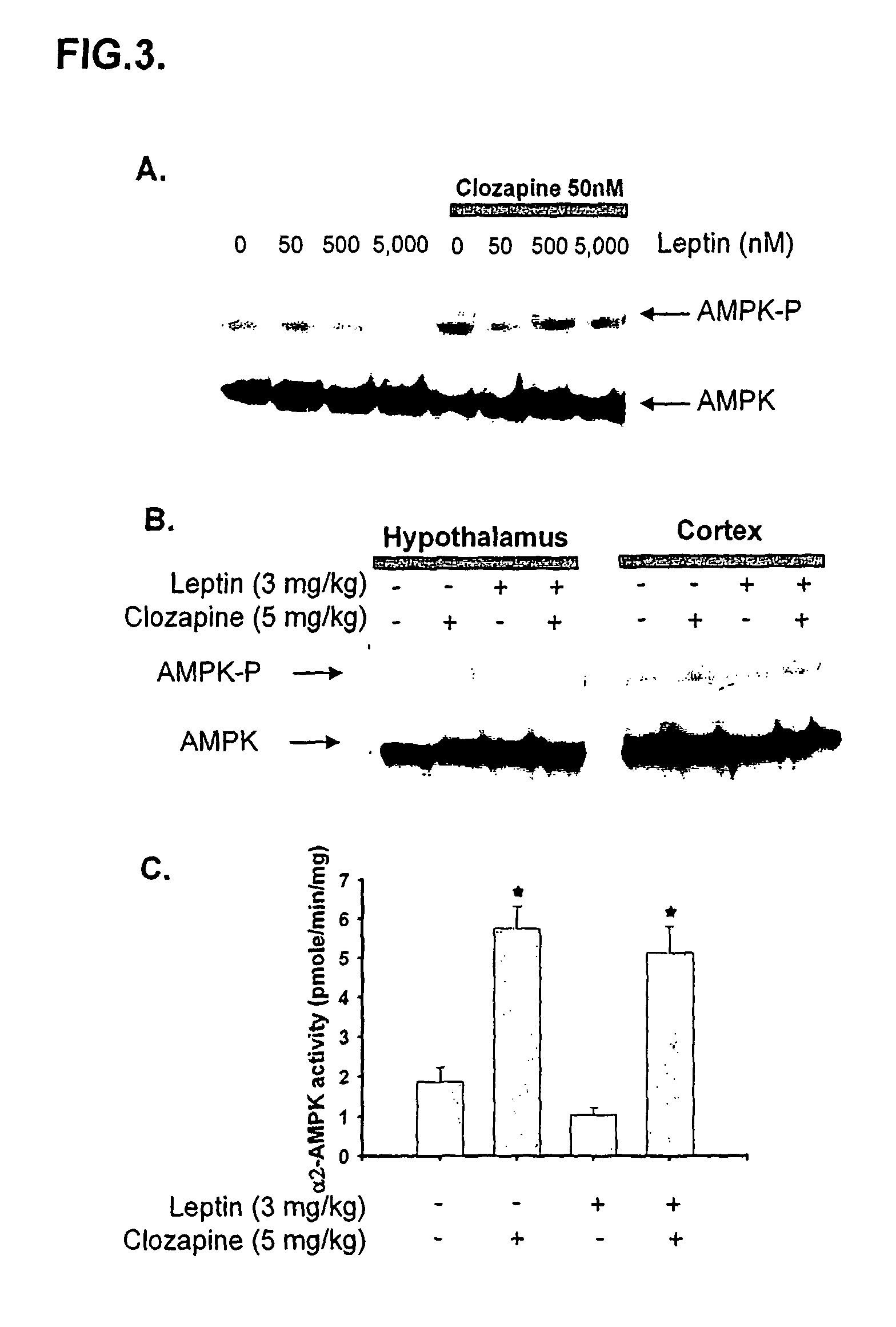Methods for predicting psychotropic drugs which elicit weight gain
a psychotropic drug and weight gain technology, applied in the field of psychotropic drugs, can solve the problems of high non-responder rate, failure of negative symptoms such as apathy to respond, and impeded use of such drugs
- Summary
- Abstract
- Description
- Claims
- Application Information
AI Technical Summary
Benefits of technology
Problems solved by technology
Method used
Image
Examples
example 1
[0030]In hypothalamic slices, clozapine and olazapine markedly enhance levels of phospho-AMPK, and quetiapine, which also is orexigenic, produces similar effects (FIG. 1A). However, risperidone, ziprasidone, haloperidol, and aripipirazole, which are much less orexigenic (Table 1), fail to stimulate AMPK (FIG. 1B). Increased AMPK phosphorylation is observed as early as 5 min after treatment with clozapine or olanzapine (FIGS. 1C and D). The drug actions are potent and substantial with EC50 values for both of about 10 nM and with six and 3.5 fold maximal increases respectively with clozapine and olanzapine (FIGS. 1 E-H).
[0031]
TABLE 1Drugs*IC50 (nM)Orexigenic Effects5,8,14Clozapine 9++++Olanzapine 13+++Quetiapine 40++Risperidone 80+ / −Ziprasidone150−Haloperidol2000>−Aripipirazole3000>−
Neuroleptic affinities for histamine H1 receptors correlate with orexigenic actions. Receptor binding was assayed using rat brain membranes incubated with [3H]mepyramine and 12 concentrations of drugs rang...
example 2
[0036]Clozapine also potently and selectively augments hypothalamic AMPK in intact animals. As little as 1 mg / kg of clozapine markedly stimulates levels of phospho-AMPK (FIG. 2 A) as well as AMPK catalytic activity with 5 mg / kg producing a 3.5 folds, augmentation of activity (FIG. 2 B). The increase of phospho-AMPK and AMPK catalytic activity is selective for the hypothalamus, as clozapine (1 mg / kg) fails to increase phospho-AMPK levels in the cerebellum and liver (FIGS. 5 A and 5B) and AMPK catalytic activity is not affected in the cerebral cortex or cerebellum by clozapine (1 mg / kg) (FIG. 2 C). At 5 mg / kg, clozapine elicits a 20% increase in cortical AMPK activity, much less than the quadrupling of hypothalamic AMPK activity, while no increase is apparent in the cerebellum (FIG. 2 D). The effect of clozapine is maximal 3 h after drug-administration and gradually decreases to basal levels in 24 h (FIG. 5 F).
example 3
[0037]Kahn and colleagues (11) reported that the anorexigenic peptide leptin reduces hypothalamic AMPK activity, which we confirm. Clozapine reverses reductions in hypothalamic phospho-AMPK elicited by leptin (FIG. 3 A) and insulin (11) (FIG. 6). In intact mice, leptin (3 mg / kg) reduces hypothalamic phospho-AMPK (FIG. 3 B) and catalytic activity (FIG. 3C), and clozapine reverses these actions.
[0038]The arcuate and paraventricular hypothalamic nuclei display the greatest alterations of AMPK activity in response to feeding stimuli (11). In immunohistochemical experiments phospho-AMPK is selectively augmented in these two nuclei with clozapine (1 and 5 mg / kg) while much lesser effects are evident in the cerebral cortex (FIGS. 7A and B). By contrast, ziprasidone fails to alter phospho-AMPK in the paraventricular nucleus (FIG. 8).
[0039]Phospho-AMPKα immunohistochemistry was performed as previously described (E. K. Kim et al., J. Biol. Chem. 279, 19970 (2004); A. S. Hu...
PUM
| Property | Measurement | Unit |
|---|---|---|
| temperature | aaaaa | aaaaa |
| temperature | aaaaa | aaaaa |
| temperature | aaaaa | aaaaa |
Abstract
Description
Claims
Application Information
 Login to View More
Login to View More - R&D
- Intellectual Property
- Life Sciences
- Materials
- Tech Scout
- Unparalleled Data Quality
- Higher Quality Content
- 60% Fewer Hallucinations
Browse by: Latest US Patents, China's latest patents, Technical Efficacy Thesaurus, Application Domain, Technology Topic, Popular Technical Reports.
© 2025 PatSnap. All rights reserved.Legal|Privacy policy|Modern Slavery Act Transparency Statement|Sitemap|About US| Contact US: help@patsnap.com



